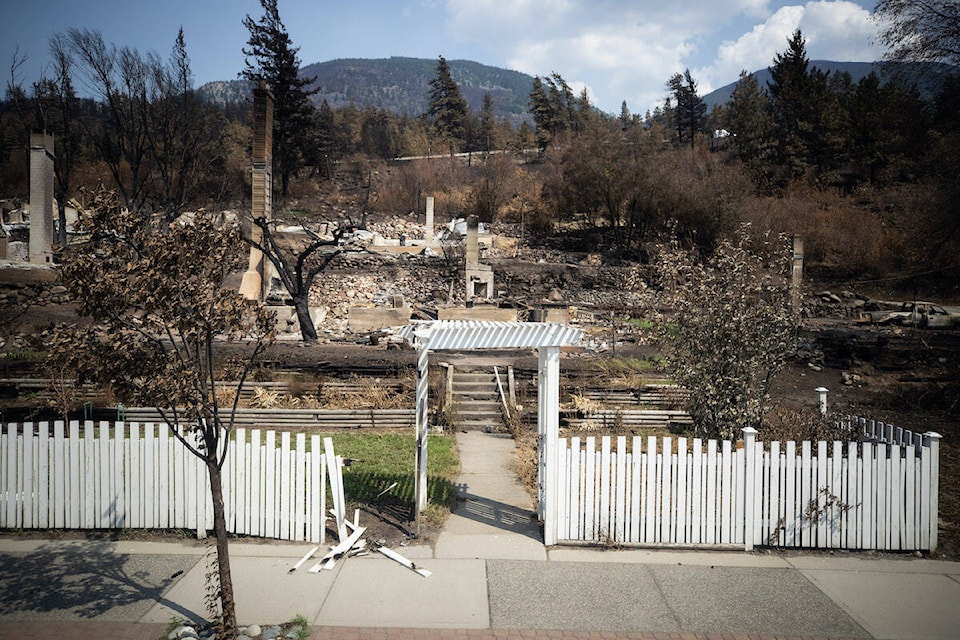Denise O’Connor is back in Lytton, B.C., living in the home where she spent her childhood years.
But it’s not where she was living last summer when a wildfire swept through the Fraser Canyon village and destroyed almost everything in its path, including the house with a river view where O’Connor, 63, lived for more than 30 years.
“I’m not kidding, I couldn’t believe what I was seeing with the smoke,” she said in an interview. “I saw trees on fire. I could tell buildings were on fire. I grabbed some things and we got in the car and left.”
The fire on June 30 roared through Lytton just one day after the temperature in the village hit an all-time Canadian high of 49.6 C.
O’Connor said after living in a motel in Kamloops, a temporary vacation rental in Merritt and with her daughter in Quesnel, she returned to Lytton in the fall with her husband Chris. They moved into her father’s home, which was missed by the fire.
“Everywhere we lived, it wasn’t home,” she said.
The possibility of future homecomings for Lytton residents recently took a step forward after more than seven months of inertia from the provincial and local governments, O’Connor said.
“We’ve been told so many times, soon, soon,” said O’Connor, who has raised concerns about the recovery process since the fire. “It’s going to happen soon. It never has. It’s moved way too slowly.”
Lytton Mayor Jan Polderman said he became emotional at a recent council meeting when he announced B.C. government funding of $8.3 million to support ongoing operations and recovery for the village.
“You’ve got to realize, I mean, the village was within a week or two weeks of not being able to meet its bills,” Polderman said this week in an interview.
“The Village of Lytton would have been no more,” he said. “We were broke. We’ve been broke for quite a while.”
The council has now started the long-awaited process of hiring a contractor to start removing debris before new homes can be built, possibly by this fall, Polderman said.
With so much infrastructure destroyed, Polderman said the municipality has a chance to rebuild differently, but it must weigh the costs and time.
Council has approved grant applications that allow it to explore plans for a new sewage system, net-zero building construction and an analysis of advancements in infrastructure, he said.
“We don’t want to invest in technologies that don’t have a payback to them or don’t work,” Polderman told a recent online council meeting.
He said the village has heard presentations about solar sidewalks, solar roads, electric smart grids and electric storage.
BC Hydro has briefed council on the differences between installing underground or above ground power lines. A Hydro official said above ground power would take six to nine months to build at no cost to the village, but power below ground would take up to 29 months to complete and come with a $4 million cost.
The council has also heard from the Insurance Bureau of Canada that delays in recovery and reconstruction costs have increased insured damage estimates to $102 million from $78 million. Rob de Pruis, the bureau’s consumer and industry relations director, told council that living expenses for insured homeowners are not infinite and most policies include time limits to settle claims.
“We want to support the community as best we can,” he said.
Jackie Tegart, a B.C. Liberal who represents Lytton in the legislature, said the province’s NDP government did not move quickly enough to help Lytton following the fire. Now, more than seven months later, people are frustrated and angry, she said.
“The provincial government has a role to play here, and I would suggest to you dribs and drabs are not good enough,” she said in an interview. “We need consistency. We need a vision. We need a plan, and here we are seven months later.”
Public Safety Minister Mike Farnworth said the government is committed to rebuilding Lytton.
“Recovery is never quick,” he said in an interview. “In this particular case, you’re dealing with a community that lost its infrastructure, everything. I totally understand it’s frustrating for people who want to rebuild. We want them to be able to rebuild as well.”
O’Connor said residents realized shortly after the fire that the council did not have the resources to manage the aftermath of the disaster, but the province was slow to react.
“We saw nothing for four or five months. We didn’t have a clue what was going on.”
Chief Janet Webster of the Lytton First Nation said she was able to receive federal and provincial funds shortly after the fire and clearing work is underway to put in temporary modular homes for many of its 160 members who are living away from the band’s territory.
“We’re moving slowly but surely,” she said. “Once we start seeing the modular homes come in, I think it will be a little relief for the people so they can come back home.”
John Haugen, a Lytton First Nation member who was living in the village at the time of the fire, said his uninsured home was destroyed in the blaze.
Haugen, who has lived with friends in Merritt, Boston Bar and the Lytton area since the fire, said his extended family lost four homes and one business on Main Street.
“I can see my way out of this because it’s something we were meant to do,” he said. “If the challenge is there, you have to just overcome it. You can’t sit back and wait. But there are a lot of barriers in place.”
Dirk Meissner, The Canadian Press
